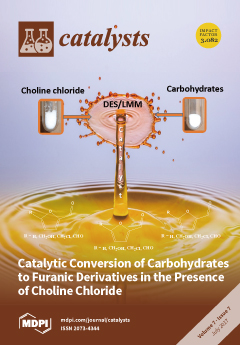Metal complexes of
meso-arylporphyrins (Cr(III), Fe(III), and Zn(II)) were evaluated in the coupling reaction of cyclohexene oxide (CHO) with CO
2 in compressed medium, where the Cr complexes were demonstrated to be the most active systems, leading predominantly to copolymerisation products. It
[...] Read more.
Metal complexes of
meso-arylporphyrins (Cr(III), Fe(III), and Zn(II)) were evaluated in the coupling reaction of cyclohexene oxide (CHO) with CO
2 in compressed medium, where the Cr complexes were demonstrated to be the most active systems, leading predominantly to copolymerisation products. It is noteworthy that no addition of solvent was required. To improve the catalytic activity, and to simultaneously increase the solubility in compressed CO
2, a new fluorinated catalyst, tetrakis(4-trifluoromethylphenyl)porphyrinatochromium(III) chloride (CrCl-
pCF
3TPP), was applied to this reaction. The alternating copolymerisation of CHO with CO
2, using the Cr(III) fluorinated porphyrin catalyst, required the use of a co-catalyst, bis(triphenylphosphine)iminium chloride (PPNCl), with the best yields of copolymers being obtained at 80 °C, and CO
2 pressures in the range of 50–110 bar, over a period of 24 h, with a low catalyst/substrate molar ratio (0.07%). The polycarbonate’s structure was analysed by
1H NMR,
13C NMR, and MALDI-TOF spectroscopy, which demonstrated high carbonate incorporations (98–99%). Gel permeation chromatography revealed number-average molecular weights (
Mn) in the range of 4800–12,800 and narrow molecular weight distributions (
Mw/
Mn ≤ 1.63).
Full article





